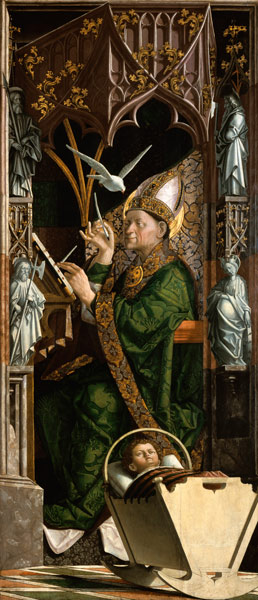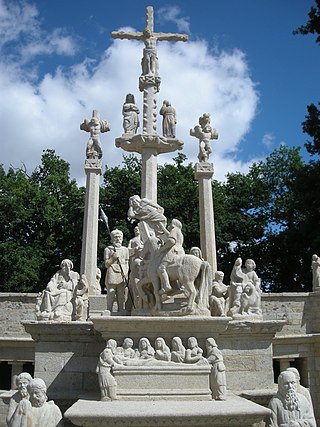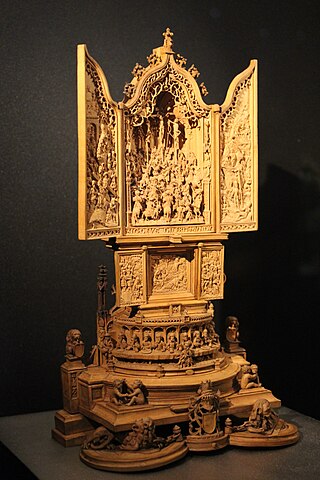
The Madonna della Pietà, informally known as La Pietà, is a marble sculpture of Jesus and Mary at Mount Golgotha representing the "Sixth Sorrow" of the Blessed Virgin Mary by Michelangelo Buonarroti, now in Saint Peter's Basilica, Vatican City. It is a key work of Italian Renaissance sculpture and often taken as the start of the High Renaissance.

The Pietà is a subject in Christian art depicting the Blessed Virgin Mary cradling the mortal body of Jesus Christ after his Descent from the Cross. It is most often found in sculpture. The Pietà is a specific form of the Lamentation of Christ in which Jesus is mourned by sole privilege of the Virgin Mary alone, whilst representing her "sixth sorrow" and sometimes accompanied by a specific Marian title.

Michael Pacher was a painter and sculptor from Tyrol active during the second half of the fifteenth century. He was one of the earliest artists to introduce the principles of Renaissance painting into Germany. Pacher was a comprehensive artist with a broad range of sculpting, painting, and architecture skills producing works of complex wood and stone. He painted structures for altarpieces on a scale unparalleled in North European art.

The term Poor Man's Bible has come into use in modern times to describe works of art within churches and cathedrals which either individually or collectively have been created to illustrate the teachings of the Bible for a largely illiterate population. These artworks may take the form of carvings, paintings, mosaics or stained-glass windows. In some churches a single artwork, such as a stained-glass window, has the role of Poor Man's Bible, while in others, the entire church is decorated with a complex biblical narrative that unites in a single scheme.

The Church of St. Peter and St. Paul is a Roman Catholic church located in the Antakalnis neighbourhood of Vilnius, Lithuania. It is the centerpiece of a former monastery complex of the Canons Regular of the Lateran. Its interior has masterful compositions of some 2,000 stucco figures by Giovanni Pietro Perti and ornamentation by Giovanni Maria Galli and is unique in Europe. The church is considered a masterpiece of the Polish–Lithuanian Commonwealth Baroque. It was funded by Michał Kazimierz Pac, commemorating a victory over the Muscovites and their expulsion from Vilnius after six years of occupation.

The Basilica of Saint Clotilde is a basilica church located on the Rue Las Cases, in the 7th arrondissement of Paris. It was constructed between 1846 and 1856, and is the first example of a church in Paris in the neo-Gothic style.

The Pensive Christ is a subject in Christian iconography depicting a contemplating Jesus, sitting with his head supported by his hand with the Crown of Thorns and marks of his flagellation. It is, therefore, a picture of Jesus shortly before his crucifixion, although more an andachtsbild or devotional subject than intended to show an actual moment in the narrative of the Passion of Christ. The Pensive Christ is much more common in sculpture than in painting, where the similar Man of Sorrows is more often depicted.

Located at 6, rue Notre-Dame-des-Victoires, in the 2nd arrondissement of Paris, The Basilica of Notre-Dame-des-Victoires is one of ten minor basilicas located in the Île-de-France region of France. It was begun as an Abbey church, and constructed between 1629 and 1740 in the French classical style. Its name was given by King Louis XIII, who dedicated it to his victory over the Protestants at La Rochelle in 1628 during the French Wars of Religion. Notre-Dame-des-Victoires is famous for the ex voto offerings left there by the faithful. Over 37,000 devotional plaques, silver and gold hearts, as well as military decorations, have been left at the basilica. The closest Métro station is 'Bourse'.
Paul Ondrusch was a German sculptor who created religious works of art. Ondrusch was an active artist in Silesian towns and villages at the time when they belonged to the German Empire and later when they were part of Weimar Republic and the Third Reich since 1919 and 1933 respectively. After the Second World War he moved to Germany when his hometown was included in the territory of post-war communist-ruled Poland in 1945.

Philip Lindsey Clark (1889–1977) was an English sculptor.

The Co-Cathedral of Saint Nicholas in Prešov is one of the oldest and most important churches in Slovakia. The external dimensions of the cathedral are 54.7m in length, 34.45m in width. The indoor nave is 16 m tall and tower reaches a height of 71 meters. The temple's design takes inspiration from the Late Gothic hall churches with three naves.
This is a listing of some of the works of Jean Fréour.

The Calvary of Guéhenno, dating from 1550, is located in the village of Guéhenno in the Pontivy arrondissement of Brittany. This article gives a full description of the calvary and details of how it was rebuilt after suffering severe damage in 1794. This calvary is classified as one of the seven great calvaries of Brittany and is the furthest to the east, being located in the ancient diocese of Vannes. It is made entirely from granite save for some bas-reliefs carved using "pierre bleutėe". The granite used is fine grained which lends itself to being carved. Extracted from the Guéhenno region, it was also used for the north porch at Ploërmel and the façade of the château at Josselin.

The Locmélar Parish close is located at Locmélar in the arrondissement of Morlaix in Brittany in north-western France. It is a listed historical monument since 1934.

Pietà a small painted wood sculpture dated to c. 1375–1400, now in the collection of the Cloisters, New York. Very little is known of it, except that is probably of southern German origin. The statuette emphasises the suffering of both the Virgin and Jesus Christ.

Franz Tavella was a Ladin master wood sculptor active in the Austro-Hungarian Empire and the Kingdom of Italy.

Ludwig Moroder "Lenert" was an Italian sculptor and teacher. He was also known as:Ludwig Moroder dl Meune or Lodovico Moroder.

The miniature altarpiece in the British Museum, London, is a very small portable Gothic boxwood miniature sculpture completed in 1511 by the Northern Netherlands master sometimes identified as Adam Dircksz, and members of his workshop. At 25.1 cm (9.9 in) high, it is built from a series of architectural layers or registers, which culminate at an upper triptych, whose center panel contains a minutely detailed and intricate Crucifixion scene filled with multitudes of figures in relief. Its outer wings show Christ Carrying the Cross on the left, and the Resurrection on the right.

Renaissance sculpture is understood as a process of recovery of the sculpture of classical antiquity. Sculptors found in the artistic remains and in the discoveries of sites of that bygone era the perfect inspiration for their works. They were also inspired by nature. In this context we must take into account the exception of the Flemish artists in northern Europe, who, in addition to overcoming the figurative style of the Gothic, promoted a Renaissance foreign to the Italian one, especially in the field of painting. The rebirth of antiquity with the abandonment of the medieval, which for Giorgio Vasari "had been a world of Goths", and the recognition of the classics with all their variants and nuances was a phenomenon that developed almost exclusively in Italian Renaissance sculpture. Renaissance art succeeded in interpreting Nature and translating it with freedom and knowledge into a multitude of masterpieces.

Saint Elizabeth of Hungary Church is a Roman Catholic church located at 195 rue du Temple, near Place de la Republique in the 3rd arrondissement of Paris, France. It is named for Saint Elizabeth of Hungary, a Princess of Hungary in the 13th century who became known as a symbol of Christian charity.





















